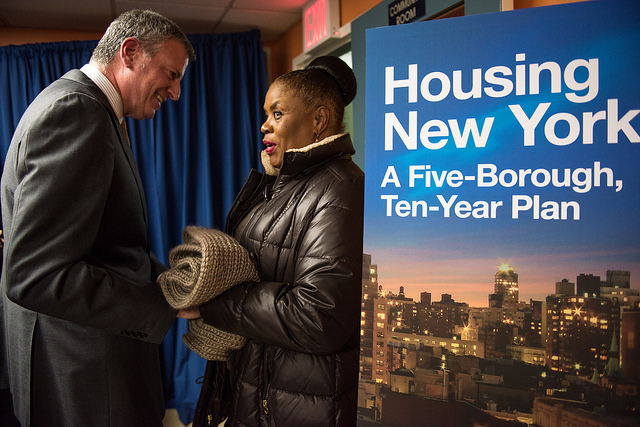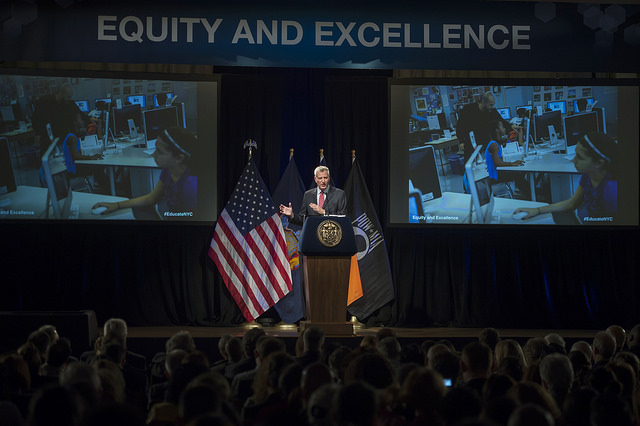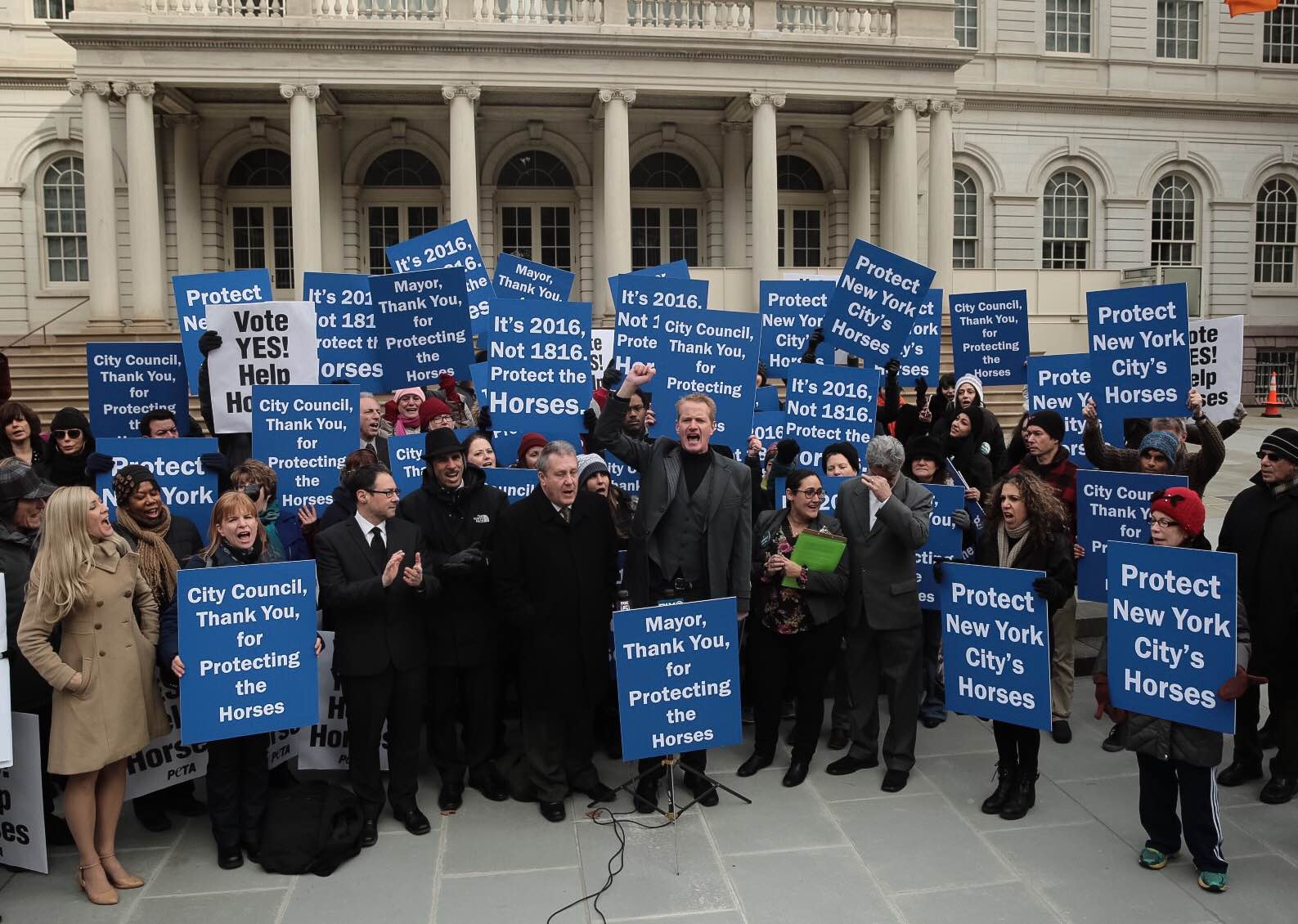Real Affordable Housing for Our Communities

photo: Demetrius Freeman/Mayoral Photography Office
When I think about my family's future in New York City, I wonder: will there be an affordable, safe, and healthy apartment where I can raise my children and still be able to provide them with everything else that they need?
This is the question that our city government has to address if it wants to protect low-income and working class New Yorkers.
My husband and I live in Bushwick in a one-bedroom apartment with our three children—one of whom has special needs—and my sister. We pay more than $1,200 per month—more than half of our income, which comes from my husband's job in a fruit and vegetable store. For the last two years, we've been looking to find somewhere better—somewhere more affordable, with more space for our children. Our landlord wants us out, too, because he wants to renovate and charge new tenants more as Bushwick gentrifies.
But there's nowhere for us to go. Even studios near where we live are now renting for $1,400-$1,500—too much money, and too little space, for our family of six.
In recent weeks, the city has heard much debate on how to create and preserve affordable housing. The most talked-about item has been the Mayor's Mandatory Inclusionary Housing (MIH) plan, which would exchange zoning changes to allow more housing construction for, in most neighborhoods, the requirement that 25–30 percent of apartments be affordable to people earning 60 to 80 percent of Area Median Income (AMI).
The problem with the plan is that it won't solve the problem for working class New Yorkers like me.
Sixty percent of Area Median Income is almost $47,000 for a family of three, and many New Yorkers are far from earning that. My family of six earns about half that much.
As a recent Real Affordability for All (RAFA) report found, in many of the neighborhoods that are being rezoned—like East New York, the South Bronx, and East Harlem—the average income is far below 60 percent of Area Median Income. So, when I look at the MIH plan, I wonder: "affordable" housing for whom? Certainly not for local residents like me.
Mayor de Blasio stood on the right side with our communities in the Fight for $15, to raise the minimum wage to $15 per hour for the 3.2 million low-wage workers in our state who currently earn less. But the reality is that, even once our families win the $15 per hour that we so desperately need, the vast majority of the housing being proposed in the MIH plan will not be affordable to us.
We ask the Mayor to reconsider his plan and expand affordability to preserve and build genuinely affordable housing.
***
Susana Salas is a member of Make the Road New York, the largest grassroots community organization in New York offering services and organizing the immigrant community. On Twitter: @maketheroadny.
Is Mayor De Blasio Putting Students First?

Mayor de Blasio (photo via The Mayor's Office)
Mayor de Blasio's annual State of the City address is a natural time to take a step back and review his performance running the largest school system in the United States. For StudentsFirstNY, our most basic litmus test for policymakers is a simple question – are they putting the interests of students first? After two full years with Mayor de Blasio, we can definitively say that the answer is "no."
In analyzing Mayor de Blasio's stewardship of city schools, there are several themes that emerge. First, there is a distinct lack of urgency in delivering results for students. Second, his policies are not based on research. He has ignored evidence that programs like small schools and expanded choice work. Third, he has not shown results on failing schools. And finally, the mayor has ignored teacher quality.
Throughout the course of his time in office, this mayor has not shown much fondness for the details of his job. He seems more comfortable pondering the course of progressive philosophy or knocking on doors in Iowa, for example, than he does in setting specific timelines and metrics for results. Take his much-hyped program to have every child read by third grade. The goal is noble, but he doesn't promise results that can be measured until 2026 – long after he is gone from office. What good does that do for kids who will be trying to learn to read this year, or next year, or for years after that?
A strong education leader understands that setting realistic short-term targets is essential to tracking results and ensuring progress towards a greater goal. Without real, deliverable metrics, these programs are little more than press releases with empty promises that may never come to fruition.
Another hallmark of Mayor de Blasio's time in office has been a fundamental rejection of data and research-based decision-making. Under Mayor Bloomberg, the school system was improving – but Mayor de Blasio has rejected the use of evidence as a personal rebuke of his predecessor. In its place is a menu of nice sounding initiatives that have never been shown to actually improve educational outcomes for kids.
Time and time again, Mayor de Blasio has opted to make education decisions based on politics, even when it means rejecting policies that have a proven track record of success. Take small schools as an example. Countless studies have shown that small schools work, but the de Blasio administration has rejected them for political reasons.
The same is true with charter schools. Even though New York City has the longest waiting list in the country, with tens of thousands of parents hoping to get spots for their kids in charter schools, the mayor has fought tooth-and-nail against them. Why? It's not about serving kids; the mayor's political allies in the teachers union want to stifle their competition.
These politically-motivated decisions threaten to trap another generation of students in failing schools, with no hope of a turnaround. The "Renewal" model was supposed to be Mayor de Blasio's signature program, but so far it has accomplished little for kids in the city's lowest performing schools. Some Renewal schools hit their target goals before the program had even started – a sure sign of artificially low expectations. And despite the claims of progress, objective student achievement measures show that these schools continue to perform poorly.
Finally, Mayor de Blasio has not lifted a finger to improve teacher quality. He missed a golden opportunity to improve teacher quality with fundamental reforms during the 2014 teacher contract negotiations. Instead of reform, de Blasio caved to the UFT on every key issue – everything from merit pay for great teachers to eliminating the unwanted teachers from the ATR pool. The mayor likes to call this "collaboration," but in reality, the UFT gets what it wants at the expense of kids. So students are stuck with ineffective teachers and the teachers that no principal wants are forced back into the classroom.
At the end of the day, we need to know that students are learning and have access to the highest quality schools possible. Halfway through Mayor de Blasio's term, it's not enough to talk a good game. It's time to deliver results.
***
Jenny Sedlis is the Executive Director of StudentsFirstNY. On Twitter @JennySedlis & @StudentsFirstNY.
***
Have an op-ed idea or submission for Gotham Gazette? Email This email address is being protected from spambots. You need JavaScript enabled to view it.
A Good Deal for Horses

photo via NYCLASS
***Editor's note: this op-ed column was published in anticipation of a vote on legislation that did not occur when a deal fell apart at the last minute on Thursday, Feb. 4, 2015 ***
The The New York City Council has the opportunity this week to take carriage horses out of dangerous city traffic and create new protections that will help these horses lead happier, safer lives.
They should jump at the opportunity.
For all of the political back and forth, this is a smart, sensible plan – especially if your goal is to protect horses. Consider the details of the plan:
First, it reduces the number of carriage horses by nearly half and protects them from being sold into slaughter when they are done working. NYCLASS has publicly stated that we are willing to pay – without the use of a single dime of taxpayer funds – for these retired horses to be sent to a sanctuary. So ignore any false rhetoric about these retired horses being sold to slaughter - it's just not true.
Second, the plan requires that the remaining carriage horses live and work in Central Park, not in dangerous city traffic. New York City streets are loud and congested with honking taxis, ambulance sirens, and double-decker buses. That's a reality that horses should not be forced to manage. Under this plan, they won't have to.
Third, it nearly doubles the stall size for each horse to 100 square feet and provides daily time and space for horses to roam – essential elements for protecting the horses' mental and physical well-being.
Some have falsely claimed that having half the number of horses will mean that the remaining horses will be worked twice as much. This is simply not true. The legislation limits the horses to working only one shift per day and there are clear penalties for overworking any horse.
None of these protections exist today and everyone who loves horses should support them.
Of course, there are some opponents now pushing the City Council to follow the "delay to death" strategy – dragging this process out even further. Enough is enough. We have debated and discussed this for years. Heck, the City Council passed – and the editorial boards of both the New York Times and the New York Daily News supported – legislation to move the horses into the Park in 1988! The time for debate is over. The Council needs to do what is right and pass this legislation.
What's more, delaying the process isn't a solution; it only allows opponents to continue to spread misinformation, particularly regarding bizarre real estate conspiracy theories. Let's set the record straight – again – on this: the stables are privately-owned property; the owners can do whatever they want with them. No one at NYCLASS, including our founder Steve Nislick, has or will have anything to do with the West Side stables. Period.
Strangely enough, some are surprised that NYCLASS and other animal rights organizations have so strongly supported the new compromise. They shouldn't be. Our number one priority is and always has been to protect the horses in the best and most practical way we know how. This plan does that.
The same can't be said for those supporting the status quo. These individuals claim that the horses are well cared for. This couldn't be further from the truth. Carriage horses are forced to live their entire non-working lives in small, confined stalls without access to open pastures. They travel to work through dangerous city traffic, forced to dodge enormous trucks, speeding cars, and bicycles, often spooking, and in too many cases, they are struck and injured. Are these proper conditions for beloved animals? We certainly don't think so. That's why numerous animal protection organizations such as the ASPCA and the Humane Society of the United States support this plan too.
Other opponents claim that the compromise doesn't go far enough. They want a complete ban on horse carriages. While we are sympathetic to these passionate voices, we believe that New Yorkers should support the proposed legislation because it helps achieve our number one priority: protecting and improving the lives of carriage horses. This compromise is a real-world solution to a problem that should have been eradicated decades ago.
It is time for us all to come together on the most important point: horses – as all animals – should be treated humanely and with care.
This new compromise is our opportunity to do just that. Because protecting our city's precious animals is not a choice, it's an imperative.
***
Allie Feldman is the Executive Director of NYCLASS. On Twitter @NYCLASS.
***
Have an op-ed idea or submission for Gotham Gazette? Email This email address is being protected from spambots. You need JavaScript enabled to view it.




